The Derek Chauvin Trial — Day Eight
Anastasia Katz, American Renaissance, April 8, 2021
Editor’s Note: See our coverage of the first day of the trial here, the second day here, and the third day here, the fourth day here, the fifth day here, the sixth day here, and the seventh day here.
Day eight began with continued testimony from the prosecution’s paid use-of-force expert, Sergeant Jody Stiger. He is a black man who spent his law-enforcement career with the Los Angeles Police Department. Yesterday, he began his testimony by saying he thought Mr. Chauvin had used excessive force on George Floyd.
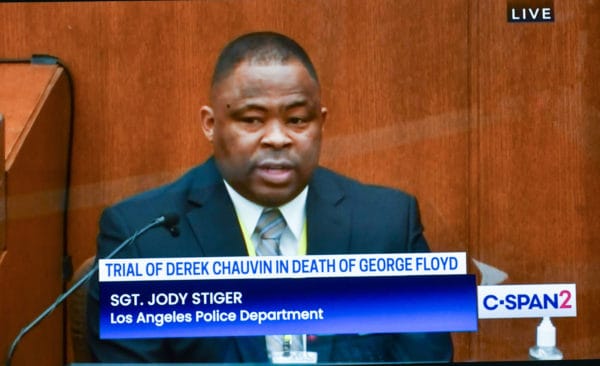
Credit Image: © Pool Video Via Court Tv via ZUMA Wire
Today, the prosecution established the amount of time Mr. Chauvin restrained Floyd. Prosecutor Jerry Blackwell had said in his opening statements that this case was all about those “nine minutes and 29 seconds.”
Prosecutor Matthew Frank showed Sgt. Stiger five photos of Mr. Chauvin and Floyd, taken from various sources. The sergeant said Mr. Chauvin used his body weight to hold George Floyd down, with his left knee on Floyd’s neck and his right knee on Floyd’s back. He said that the majority of Mr. Chauvin’s weight would have been on Floyd’s body, and that Mr. Chauvin’s position did not change. In the final photo, Mr. Chauvin’s left knee is on Floyd’s shoulder blade, and his right knee is near Floyd’s cuffed hands, low on his back, but Sgt. Stiger said, “The defendant’s left knee is still on Mr. Floyd’s neck, uh, or neck area, and the right knee is on his back area.”
“So, based on your review of all the camera footage,” Mr. Frank asked, “the defendant’s body position, with that particular force, did not change for the entire restraint period?” Sergeant Stiger answered, “Correct.”
Next, the prosecution showed a photo of Mr. Chauvin’s right hand holding Floyd’s left hand, with Floyd’s hands cuffed behind his back. Mr. Chauvin appeared to be pulling Floyd’s fingers down through the cuff. Sgt. Stiger said this is a standard procedure to cause pain. An officer is supposed to stop doing this as the subject becomes more compliant, but that Mr. Chauvin did not change his hand position throughout the nine minutes and 29 seconds. The sergeant thought this was inappropriate because Floyd was not an immediate threat.
Sgt. Stiger said that the number of officers on the scene goes into what would be an appropriate level of force. In this case, there were five officers; three used their body weight to hold Floyd down; and two others were present. The sergeant said this means Floyd was not a threat.
The sergeant also discussed “proportionality;” an officer may use force only if it is proportional to the level of crime or level of resistance. Sgt. Stiger said that Mr. Chauvin used deadly force on George Floyd. A Minnesota statute defines “deadly force” as “force which the actor uses with the purpose of causing, or which the actor should reasonably know creates a substantial risk of causing death or great bodily harm.”
Sgt. Stiger said he first learned about positional asphyxia in 1995; he said it can kill a subject even without pressure on the body.
Sgt Stiger said he has been in situations in which a crowd threw rocks and bottles at the police. In reviewing video evidence, he did not see anyone throwing things or attacking the officers. He saw people using foul language, but he did not think they were a threat, so he did not “factor them into his analysis.” He said they were not a threat; they were worried about Floyd. He did admit that bystanders can be a distraction, but that the 866 hours of training Mr. Chauvin had should have been enough for him to deal with this distraction.
To prove that Mr. Chauvin was capable of “being attentive” to Floyd in spite of hostile bystanders, the prosecution played part of Officer Lane’s body cam video. This is how the video sounded to me:
Floyd: [unintelligible] . . . moving. My stomach hurts.
Chauvin: Uh, huh.
Floyd: My dick hurts.
Chauvin: Uh, huh.
Floyd: Everything hurts. (groan) [unintelligible] Please, please!
Lane: Jesus.
Floyd: (groan) I can’t breathe, officer.
Chauvin: [unintelligible] stop talking [unintelligible]
Floyd and Chauvin: [unintelligible]
Floyd: Mama!
On cross examination, Derek Chauvin’s lawyer, Eric Nelson, questioned Sergeant Stiger’s qualifications to serve as an expert, getting him to concede that he had never testified as an expert in use-of-force, and emphasizing that he got his training in another state. Sgt. Stiger agreed that different cities have different policies on tactics and use of force. Mr. Nelson asked if the sergeant had watched the Minneapolis Police Department (MPD) training videos that had been shown as PowerPoint presentations, and Sgt. Stiger said that he had not, because they were PDFs.
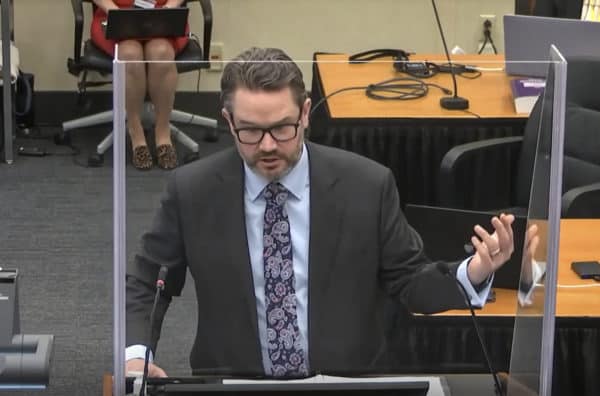
Eric Nelson, Chauvin’s defense lawyer. (Credit Image: © B4859 / Avalon/Avalon via ZUMA Press)
Sgt. Stiger agreed that according to MPD policy, one cannot use 20/20 hindsight when judging use of force. One has to allow for the fact that police officers must make split-second decisions in quickly changing situations. Mr. Nelson has often used the phrase “the totality of the circumstances,” and Sgt. Stiger said he took that into consideration when reaching his conclusions.
Mr. Nelson explained what Mr. Chauvin knew at the time. Dispatch told officers to go, Code 3 with lights and sirens, to deal with a suspect who was 6’5” and under the influence. Although Sgt. Stiger laughed and said he had seen small people put up bigger fights than big people, he agreed that a reasonable officer would have a heightened sense of concern about the call. Mr. Chauvin knew that other officers were using force even before he arrived.
When he got to the scene, he saw Floyd in the back seat of a squad car, resisting two other cops. With the information he had, he could have used his taser, but did not. In other words, Mr. Chauvin used less force than he would have been allowed to use.
Floyd was actively resisting until he was on the ground. Floyd was talking as he was being put in the car. He said, “I can’t breathe,” as he was resisting efforts to be put into the car. He used his body weight against the officers, and all three officers together could not get him into the car.
Mr. Nelson asked Sgt. Stiger if anyone had ever tried to bargain with him to avoid going to jail. Sgt. Stiger said people feign illness. Mr. Nelson asked whether Floyd’s saying he couldn’t breathe while he was violently resisting arrest was inconsistent with being unable to breathe. Sgt. Stiger said it was.
Mr. Nelson read the sergeant’s own words in the report he wrote for the state: “When the futility of the three officers continuing their efforts forcibly to seat Floyd in the squad’s back seat became clear, they put him on the ground in the prone position.”
Mr. Nelson asked Sgt. Stiger if he had used the “swarm technique,” in which multiple officers hold a suspect down. The sergeant said that this is typically done to put on handcuffs.
Mr. Nelson talked about how things can “be missed” during a chaotic arrest. He played part of the video from Officer Kueng’s body camera. Floyd is on the ground crying out, and his words are unintelligible. Mr. Nelson asked if Floyd was saying, “I ate too many drugs.” When the video was replayed, Floyd’s words sounded like “I ate too many drugs,” but Sgt. Stiger said, “I can’t make that out, no.”
Mr. Nelson showed a screenshot from a city camera video and pointed out that Mr. Chauvin’s right shoulder is lower than his left shoulder, indicating that there is less pressure on Floyd’s upper back and more pressure on the lower back. He said that use of force often leaves injuries on the suspect, a topic that will no doubt come up when the medical examiner testifies. Sgt. Stiger admitted that Mr. Chauvin’s knee was on the base of Floyd’s neck, rather than on his neck, and that Floyd had been able to lift his head slightly and turn his head.
Mr. Nelson brought up an officer’s responsibility to give first aid to someone he is arresting, including CPR in case of a heart attack. However, in order to give CPR, Floyd would have had to be taken out of his cuffs. Sgt. Stiger agreed that an unconscious subject may revive and become even more violent than before.
On redirect, Matthew Frank pointed out that positional asphyxia is not necessarily about pressure on the neck, but general pressure on the body that can make it hard to breathe. He reintroduced the concept of “in your custody, in your care,” which led Sgt. Stiger to say that an officer must believe an arrestee who is making a complaint about his medical condition; “You can’t opt not to believe.”
Mr. Nelson had mentioned “lawful but awful,” which means that the public may not find lawful police work palatable. Mr. Frank asked, “To be lawful, the force has to be objectively reasonable. If it isn’t lawful, then what’s left?” Sgt. Stiger gave a short laugh and said, “Even though the situation may be deemed lawful, in the community’s eyes, the use of force is awful . . . it looks horrible to the common eye, but based on the state law, it’s lawful.”
Mr. Frank added, “But if it’s not objectively reasonable and it’s not lawful, then it’s just awful.”
Next, the prosecution called James Reyerson, a black man who is a senior special agent with the Minnesota Bureau of Criminal Apprehension (BCA). He explained that BCA has four divisions: investigation (where he works), laboratory, information services, and training. On the day George Floyd died, his role was to investigate homicide involving use of force. His supervisor called him at 9:45 p.m. and Mr. Reyerson went to City Hall. He took photos of Mr. Chauvin in the uniform he was wearing during the incident. He said Mr. Chauvin weighed 140 pounds and was wearing a duty belt that weighed 30-40 pounds. He took the officer’s body cam, uniform, and equipment.
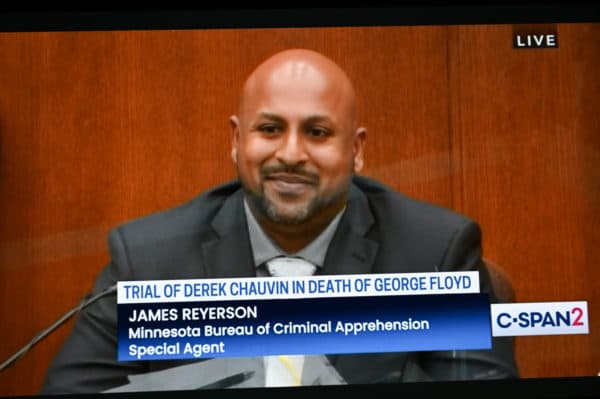
James Reyerson (Credit Image: © Pool Video Via Court Tv via ZUMA Wire)
Mr. Reyerson met forensics scientist McKenzie Anderson and other members of their crime-scene team at the scene. They took two $20 bills and a glass pipe, which they submitted for lab testing. Mr. Reyerson turned over the squad car and Floyd’s car to the agencies for analysis. He gathered body camera and surveillance camera videos, and compared timestamps. A nearby establishment, Dragon Wok, initially did not turn over its surveillance video, so they had to get a warrant for it. Mr. Reyerson watched all the video evidence.
Mr. Reyerson got the autopsy and toxicology report from the medical examiner. He had preliminary information about Floyd’s drug use from audio files and radio traffic, but he did not know which drugs he had taken. Mr. Reyerson said that the defense lawyer inspected the squad car under proper security, and at that time, he found pills in the back seat, which BCA sent to the lab.
On cross examination, Mr. Nelson confirmed that it was legal for the defense to inspect the car, and Mr. Reyerson said he was not suggesting that the defense planted the pills in the car.
Mr. Nelson asked Mr. Reyerson if he reviewed the body cam video closely, and if he ever heard Floyd say, “I ate too many drugs.” Mr. Reyerson said, “No.” After he watched the video again, he changed his mind and said, “Yes, it did” sound like Floyd had said, “I ate too many drugs.”
Mr. Nelson asked about the liquid that bystander Genevieve Hansen had noticed on the ground near Floyd and thought it might be urine. Mr. Reyerson said the liquid was condensation from the squad car.
During Mr. Frank’s redirect, Mr. Reyerson said that this was the first time he had been asked to listen to the video that sounds like Floyd saying, “I ate too many drugs.” A slightly longer part of the video was played in court, and Mr. Frank said that Mr. Reyerson should listen for the question Mr. Chauvin asks Floyd before he replies. This time, Mr. Reyerson said, “I believe Mr. Floyd is saying, ‘I ain’t doing no drugs.’”
I listened to the video more than five times, listening as carefully as I could, but I can’t make out what Floyd was saying.
The court saw video from the Dragon Wok surveillance camera. It shows Morries Hall, Floyd’s passenger, standing by Floyd’s car, at a moment when the police are not paying attention to him, Mr. Hall gets his backpack out of the car, takes something out of it, and throws it onto the street. There was no testimony about what he might have thrown.
In the afternoon, three women testified, beginning with McKenzie Anderson, who works for the Minnesota Bureau of Criminal Apprehension as a forensic scientist. On the day Floyd died, Miss Anderson came to the crime scene. She learned there was a video of what happened and she watched part of it to find the spot where Floyd was held down. She found no blood, but acknowledged that it had rained before she got there and rain could have washed blood away.
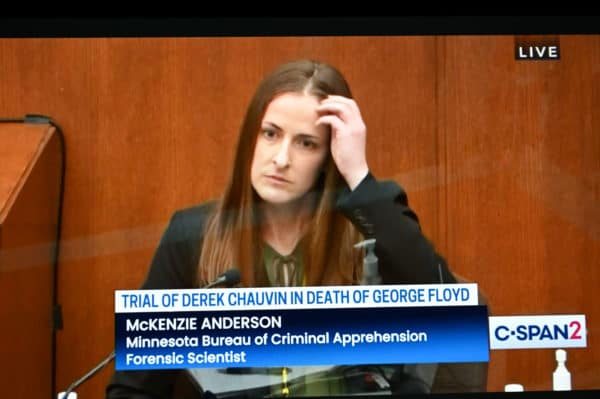
McKenzie Anderson (Credit Image: © Pool Video Via Court Tv via ZUMA Wire)
She did not collect evidence from the scene. Her team towed Floyd’s car and the squad car back to the BCA garage for processing in a controlled environment. Miss Anderson and two others photographed the outsides and insides of the cars. They went through the contents, documenting what was inside. They found a cell phone on the front passenger seat and a small white pill on the center console next to a pack of gum.
Miss Anderson searched Floyd’s car again on December 20, because there was a request to recover pills, gum, and money. Miss Anderson found an open Suboxone packet on the floor and a sealed Suboxone packet on the driver’s seat. Suboxone is used to treat patients dependent on opioids like heroin, morphine, oxycodone, or codeine. She also found two white pills in the center console, which she sent to a lab for testing.
In the squad car, Miss Anderson found a black fabric strap on the back seat and a pair of black sneakers on the floor. When she picked up the sneakers, she found a white pill on the floor. She also found four partially dissolved pills and some blood stains. The saliva on the pills and the blood matched George Floyd’s DNA.
The next forensic scientist was Breahna Giles, a BCA chemist. She spoke with a slight quiver and seemed nervous. She tested the “slightly charred” residue on a glass pipe from George Floyd’s car, and found THC, the main psycho-active ingredient in marijuana. Miss Giles tested a white, round tablet with markings that indicated it should contain oxycodone and acetaminophen. The result showed that it was a disguised pill that actually contained fentanyl and methamphetamine. The three other pills, which were smaller than the first, contained methamphetamine.
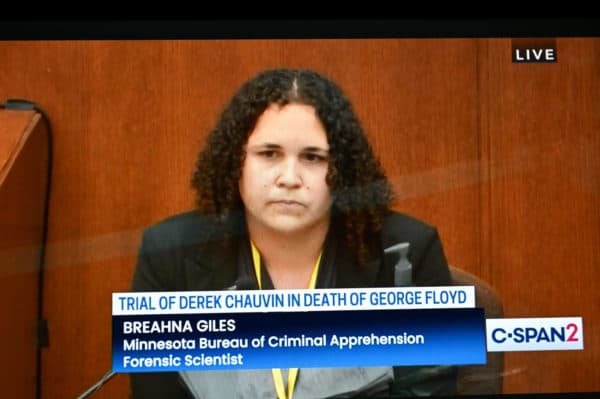
Breahna Giles (Credit Image: © Pool Video Via Court Tv via ZUMA Wire)
The last witness of the day was forensic chemist Susan Neith. She tested three partial pills recovered from George Floyd’s car and got results from two of them. Both contained less than 1 percent fentanyl and 2 percent methamphetamine. Miss Giles testified that this level of fentanyl is common in street drugs, but the methamphetamine level was lower than usual.















